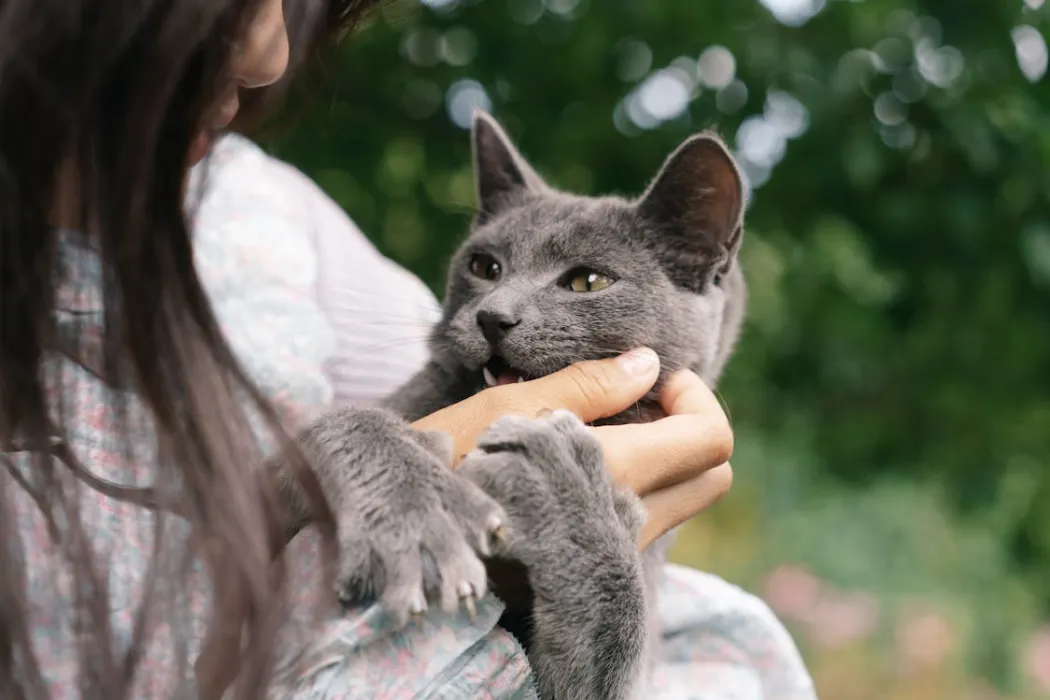Why Do Cats Purr and Then Bite You

Published by: CatsLib
5 Min Read
Mixed Emotions: Cats sometimes purr as a sign of contentment and relaxation. However, in some situations, their emotions can change quickly. Your cat might be enjoying the petting and attention (hence the purring), but then become overstimulated or irritated, leading to a bite. It's a way for them to communicate that they want the interaction to stop.
Play Behavior: Cats often use play to practice their hunting skills. Sometimes, the purring might be a sign of excitement and engagement during play, but they can get carried away and bite when their predatory instincts take over.
Redirected Aggression: Cats can experience redirected aggression when they are agitated by something they can't directly confront, such as seeing another cat outside. When you approach them, they might purr initially due to your presence, but if their underlying frustration continues, it could lead to a bite.
Communication: Cats communicate in different ways, and some cats may purr while biting as a way of expressing a complex emotion. It might be a form of communication that's specific to that individual cat.
Attention-Seeking: Some cats have learned that biting can be an effective way to get attention, even if it's negative attention. If a cat purrs to lure you in and then bites, they might be seeking interaction, even if it's in a slightly aggressive manner.
Health Issues: In some cases, cats might display changes in behavior due to underlying health problems or discomfort. If your cat's behavior suddenly changes, it's a good idea to consult with a veterinarian to rule out any medical issues.
Understanding your specific cat's body language and behavior patterns can help you interpret their intentions better. If your cat consistently displays purring and biting behavior that concerns you, it's advisable to consult with a veterinarian or a professional animal behaviorist. They can provide guidance based on your cat's individual characteristics and circumstances, helping you foster a better relationship with your furry friend.
How to Get a Cat to Stop Biting
Getting a cat to stop biting requires patience, consistent training, and understanding the underlying reasons for the behavior. Here are some steps you can take to discourage biting in your cat:
Identify Triggers: Observe when and why your cat tends to bite. Is it during play, grooming, or when they are overstimulated? Understanding the triggers can help you address the behavior more effectively.
Provide Appropriate Toys: Make sure your cat has plenty of appropriate toys to play with. Engage in interactive play sessions using toys like feather wands, laser pointers, or soft balls. Redirect their biting tendencies towards these toys.
Positive Reinforcement: Reward your cat for good behavior. When they show gentle play or refrain from biting, offer treats, praise, and pets. Positive reinforcement helps them associate positive outcomes with desirable behaviors.
Socialization and Handling: Gradually expose your cat to various types of handling and touch from a young age. This can help them become more accustomed to human interaction and reduce their tendency to bite out of fear or discomfort.
Reading Body Language: Learn to read your cat's body language. Pay attention to signs of overstimulation or irritation, such as flattened ears, swishing tail, or dilated pupils. If you notice these signs, give your cat a break from interaction.
Interrupt Play Calmly: If your cat starts biting during play, avoid using your hands as toys. If they become too rough, stop the play session calmly and walk away. This teaches them that biting leads to the end of playtime.
Use Deterrents: Some cats respond to deterrents like bitter-tasting sprays on surfaces they might bite, or using soft, short puffs of air from a can when they bite. These methods can discourage the behavior over time.
Avoid Punishment: Avoid using harsh punishment, as it can damage your cat's trust in you and escalate their anxiety or aggression. Instead, focus on positive reinforcement and redirection.
Provide Safe Spaces: Ensure your cat has access to safe spaces where they can retreat when they feel overwhelmed. This helps prevent situations where biting might occur due to stress or fear.
Consult a Professional: If the biting behavior persists or escalates, consider seeking advice from a veterinarian or a certified animal behaviorist. They can provide personalized guidance based on your cat's individual behavior and circumstances.
Remember that changing a cat's behavior takes time, so be patient and consistent in your approach. By providing appropriate outlets for play and teaching your cat alternative behaviors, you can help them learn more acceptable ways to interact with you and their environment.

How to Train Cats Not to Scratch You
Training a cat not to scratch you involves a combination of providing appropriate outlets for scratching, teaching alternative behaviors, and using positive reinforcement techniques. Here's a step-by-step approach to help train your cat not to scratch you:
Provide Scratching Posts: Cats have a natural instinct to scratch to mark territory and keep their claws healthy. Make sure you have sturdy scratching posts or pads in various locations around your home. These should be tall enough for your cat to fully stretch while scratching.
Choose Scratching Materials: Cats have preferences for different textures. Experiment with various materials such as sisal, cardboard, and fabric to find out what your cat likes. Offering a variety of textures can help satisfy their scratching needs.
Positive Reinforcement: When you catch your cat using the scratching post, praise and reward them with treats, pets, or playtime. Positive reinforcement helps them associate the scratching post with positive outcomes.
Use Cat-Friendly Deterrents: If your cat tends to scratch you or inappropriate objects, consider using double-sided tape, aluminum foil, or plastic mats on those surfaces. Cats often dislike the texture and may be deterred from scratching.
Trim Claws: Regularly trim your cat's claws to reduce the potential for accidental scratches. Use cat-specific claw clippers and be careful not to cut too close to the quick.
Teach Gentle Play: Use interactive toys to engage in play that encourages gentle behavior. Avoid using your hands as playthings to prevent your cat from associating hands with playtime.
Watch for Warning Signs: Learn to recognize your cat's body language and signs of overstimulation or irritation. If you notice these signs during play or interaction, give your cat a break.
Redirect Behavior: If your cat starts scratching you, redirect their attention to a toy or a scratching post. Gently guide their paws to the post and reward them if they engage with it.
Train the "No" Command: When your cat starts scratching you or something they shouldn't, calmly say "no" and redirect them to a scratching post or an appropriate toy. Reinforce good behavior with praise and rewards.
Consistency: Training takes time and consistency. Be patient and continue to reinforce positive behavior while discouraging unwanted scratching.
Soft Nail Caps: If scratching remains an issue, consider soft nail caps that can be placed over your cat's claws. These caps are safe and prevent scratching damage.
Remember that cats scratch for various reasons, including marking their territory and maintaining their claws. Training them not to scratch you involves providing alternatives and rewarding appropriate behavior. Be consistent in your approach and avoid punishment, as it can damage your cat's trust and relationship with you.



